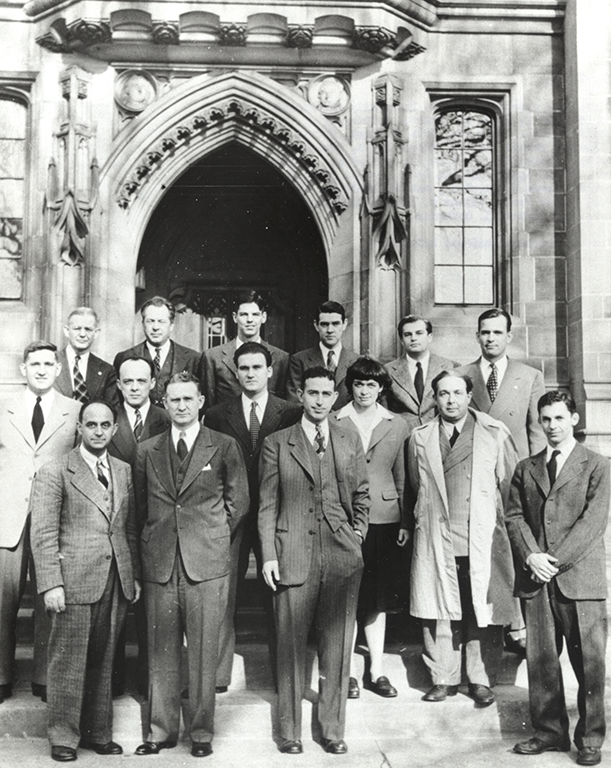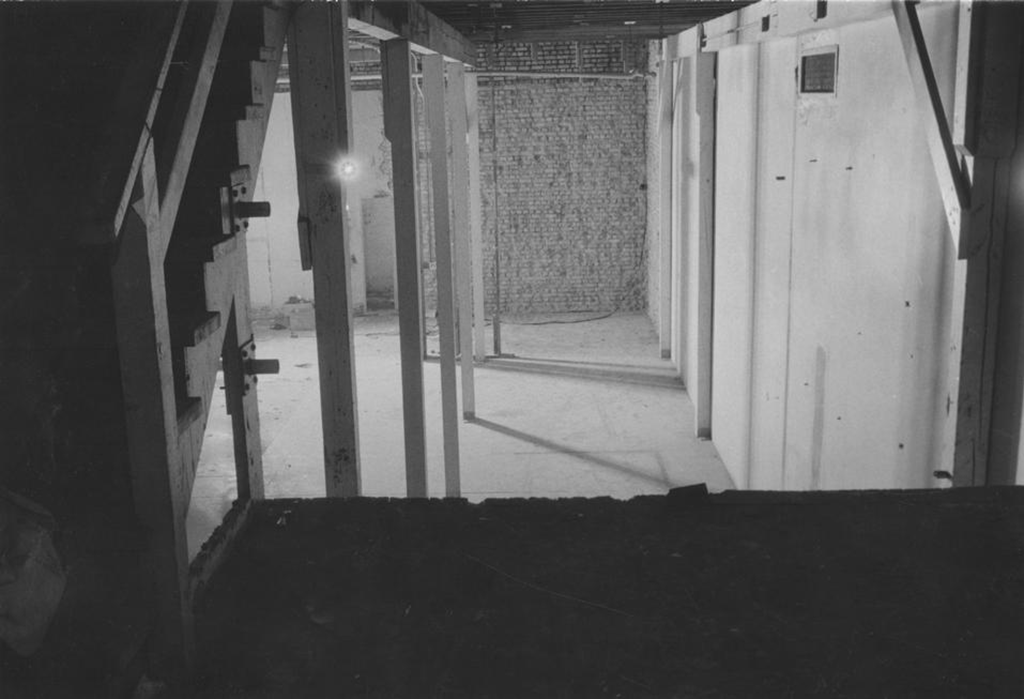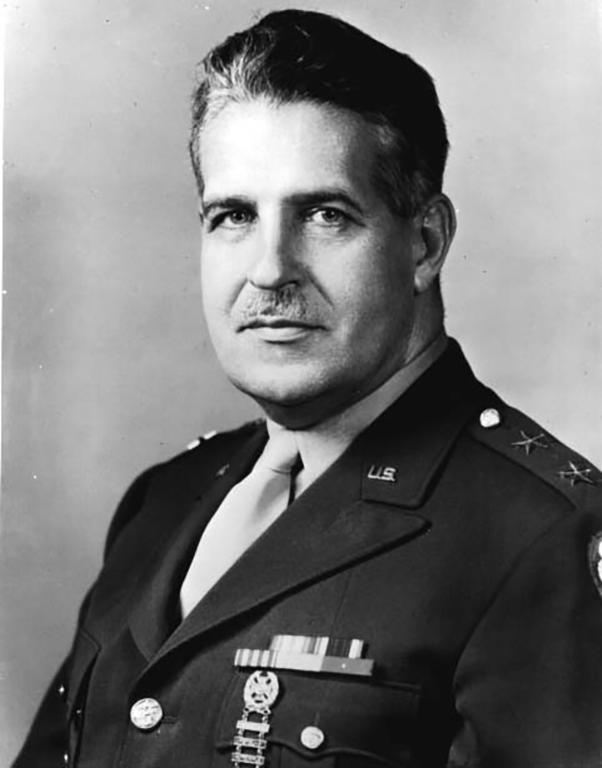The History of New Mexico
Collapse
Expand
-
Chapter 14: World War II Era: Manhattan Project & Growing Federal Presence in New Mexico
- World War II Era: Manhattan Project & Growing Federal Presence in New Mexico
- World War II
- Manhattan Project
- Site Y
- Testing the Bomb
- Impact on Local Communities
- References & Further Reading
New Mexico’s most famous connection to World War II was the location of the Manhattan Project in Los Alamos. At first glance, New Mexico seems an unlikely place to house the project that successfully created the first atomic weapons. Prior to the arrival of the Manhattan Project in 1943, the state had almost no scientific infrastructure besides limited laboratory space at the University of New Mexico. As the decade of the 1940s began, New Mexico remained primarily rural. Residents were just as likely to see people traveling by horses and wagons as by automobiles in regions outside of Albuquerque and Santa Fe.
Yet the development of nuclear technology in New Mexico was not quite as improbable as it may have seemed on the surface. Since the early Spanish-colonial period, through the Mexican period, and into the U.S. territorial period, the military played a central role in New Mexican society. During World War II, the U.S. military increased its presence in the state in a clandestine way. New Mexico’s isolation from national urban centers was the basis of its appeal.

Courtesy of Los Alamos National Laboratory
At the outset of Adolf Hitler’s expansionist campaigns, nuclear physics was in its infancy. In 1938 German and Swedish scientists discovered fission—the ability to split a uranium atom. The next year, on January 27, 1939, Niels Bohr announced their findings at a physics conference held at the George Washington University in Washington, D.C. Following the conference, physicists throughout the world replicated uranium fission. Their work suggested that an awesome source of energy from the atom was now available to humankind. Early scientific estimates indicated that uranium 235 could potentially produce as much energy as fifteen tons of TNT.
Physicists were excited by the new findings, but the question of how the technology would be used remained unanswered. Scientists also realized that much work was yet to be done in order to produce a self-sustaining fission chain reaction. In other words, the early experiments proved that a single uranium atom could be split. To realize the energy potential of fission, multiple atoms would need to split in succession. For atomic scientists around the world, the next step was to produce a fission chain reaction.
In the context of Nazi Germany’s aggression in Europe, thousands of scientists and academics fled the continent for Great Britain and the United States. Some of those that composed the exodus known as the “Brain Drain” were Jewish, and others realized that Nazis had little patience for anyone who might challenge their program of German expansion and ethnic cleansing. Nazi officials were highly suspicious of professors due to the critical nature of academic work.
Among the academic emigrants from Europe were the Hungarian physicist Edward Teller (who later developed the hydrogen bomb) and his friend and associate Albert Einstein. By that time, Einstein and a few other European scientists had earned international renown for their work. Teller considered scientific knowledge of fission among scientists who remained in Nazi Germany to be one of the most troubling threats that humankind had yet faced, as did his associates [glossary_exclude]Leo Szilard[/glossary_exclude] and Eugene P. Wigner. The trio convinced Einstein send a letter to President Franklin D. Roosevelt that expressed such concerns.
The letter was personally delivered to Roosevelt by physicist Alexander Sachs who helped to explain the details of the situation to the president. Prior to that time, the U.S. federal government had shown little interest in the development of fission. In stark contrast to Europe where theoretical physicists were popular figures and where scientific work was closely monitored by national governments, scientific experimentation in the United States transpired in the seclusion of universities that had looser connections to the federal government.
Einstein’s letter convinced Roosevelt to organize the Advisory Committee on Uranium. The commission united politicians and scientists to study the issue in the context of the brewing European conflict. Based on their findings, the committee concluded that uranium fission would not have an important impact on the war effort. As of yet, no breakthrough had been made on the question of creating a sustained nuclear chain reaction and, based on the current state of experiments in progress, one did not seem to be forthcoming.
Members of the academic scientific community, especially those who had fled Europe, were not so sure. They understood more clearly the potential for uranium fission to create a horribly destructive weapon, and they began to work in U.S. universities in an effort to produce a nuclear chain reaction before German scientists could do so. Physicists in the United States agreed to suspend the publication of their findings in order to prevent advances in their research from benefiting scientists in Nazi Germany.

Courtesy of University of Chicago Library
Working at Columbia University and then at the University of Chicago, Italian physicist Enrico Fermi and his colleague Leó Szilárd, a Hungarian physicist, hypothesized that pure carbon would work to mediate the chain reaction. German scientists had attempted to create the chain reaction using impure carbon and had failed. Although Allied scientists did not know it at the time, the Germans had abandoned carbon as an agent for the chain reaction and hoped to conduct experiments using heavy water.

Courtesy of University of Chicago Library
In December of 1942, with a group of graduate students in a racquetball court at the University of Chicago, Fermi and Szilárd conducted an experiment to test their hypothesis about pure carbon. The result was the first sustained nuclear chain reaction. Word spread among their U.S. colleagues, and eventually to representatives of the federal government. Once officials learned that a chain reaction was possible, the Roosevelt administration began to develop an official fission program. Although their work was a major breakthrough, intensive engineering was then required to translate the nuclear reaction into a weapon that could be used in the war.
General Leslie Groves led the U.S. atomic program which was placed under the purview of the Army Corps of Engineers. By the time that his team of engineers and physicists began work on the project, the United States had been involved in the war for about a year. The Japanese attack on Pearl Harbor on December 7, 1941, the “date which will live in infamy” in the words of President Roosevelt, drew the nation into World War II. Groves had the task of overseeing the creation of a powerful weapon that would cause both Japan and Germany to surrender.

Courtesy of U.S. Department of Energy
General Groves already had a reputation as one of the foremost Army engineers. He oversaw the construction of the Pentagon. The atomic program presented a number of unique challenges, not least of which was the requirement of complete secrecy. To maintain security, Groves made the decision to compartmentalize the physicists’ and engineers’ assignments. This meant that small teams of scientists worked on specific pieces of the puzzle in isolation from one another. No single group possessed complete knowledge of all facets of the project. Compartmentalization allowed Groves to include British allies in the work as well.
The operation was dubbed the Manhattan Project because several of the first scientific facilities were located in New York City. In an extension of his compartmentalized approach, Groves harnessed U.S. manufacturing and technological industries and American labor to further the work. He secured the cooperation of the General Electric, Kodak, Chrysler, and DuPont corporations, among others. Along with producing the tools and equipment that the project required, those companies helped to construct facilities to refine uranium-235 and plutonium at Oak Ridge and Hanford.
Groves served in an administrative and engineering capacity, and J. Robert Oppenheimer, a respected theoretical physicist at the University of California Berkeley, oversaw the scientific aspects of the project. Oppenheimer’s political views remain a source of debate, as his politics nearly prevented his work on the project. By his own estimation, he refrained from any sort of opinion on political matters until the Spanish Civil War broke out in 1936. He sympathized with the plight of Spanish Republicans who battled Francisco Franco’s fascist forces. To donate money to the cause, he worked through the U.S. Communist Party. He also eventually married Katherine Harrison, a party member, although he never joined the party himself. Later in life, Oppenheimer recounted his political awakening:
I woke up to a recognition that politics was a part of life. I became a real left-winger, joined the Teachers Union, had lots of Communist friends. . . . Most of what I believed then now seems complete nonsense, but it was an essential part of becoming a whole man. If it hadn’t been for this late but indispensable education, I couldn’t have done the job at Los Alamos.
Due to his affiliation with members of the Communist Party, Oppenheimer was initially denied security clearance to Manhattan Project facilities in New York and then at Site Y, despite his appointment as its director. General Groves granted him temporary clearance until he was finally granted a permanent security clearance in July of 1943.12
As he tried to coordinate the efforts of the physicists on the project, Oppenheimer realized that the compartmentalization policy was a major hindrance on their progress. He suggested to Groves that all of the scientists and engineers be relocated to a central facility in order to speed up their efforts. After much discussion, Oppenheimer convinced the general that New Mexico’s Pajarito Plateau would be an ideal location that would allow them to maintain the project’s security.